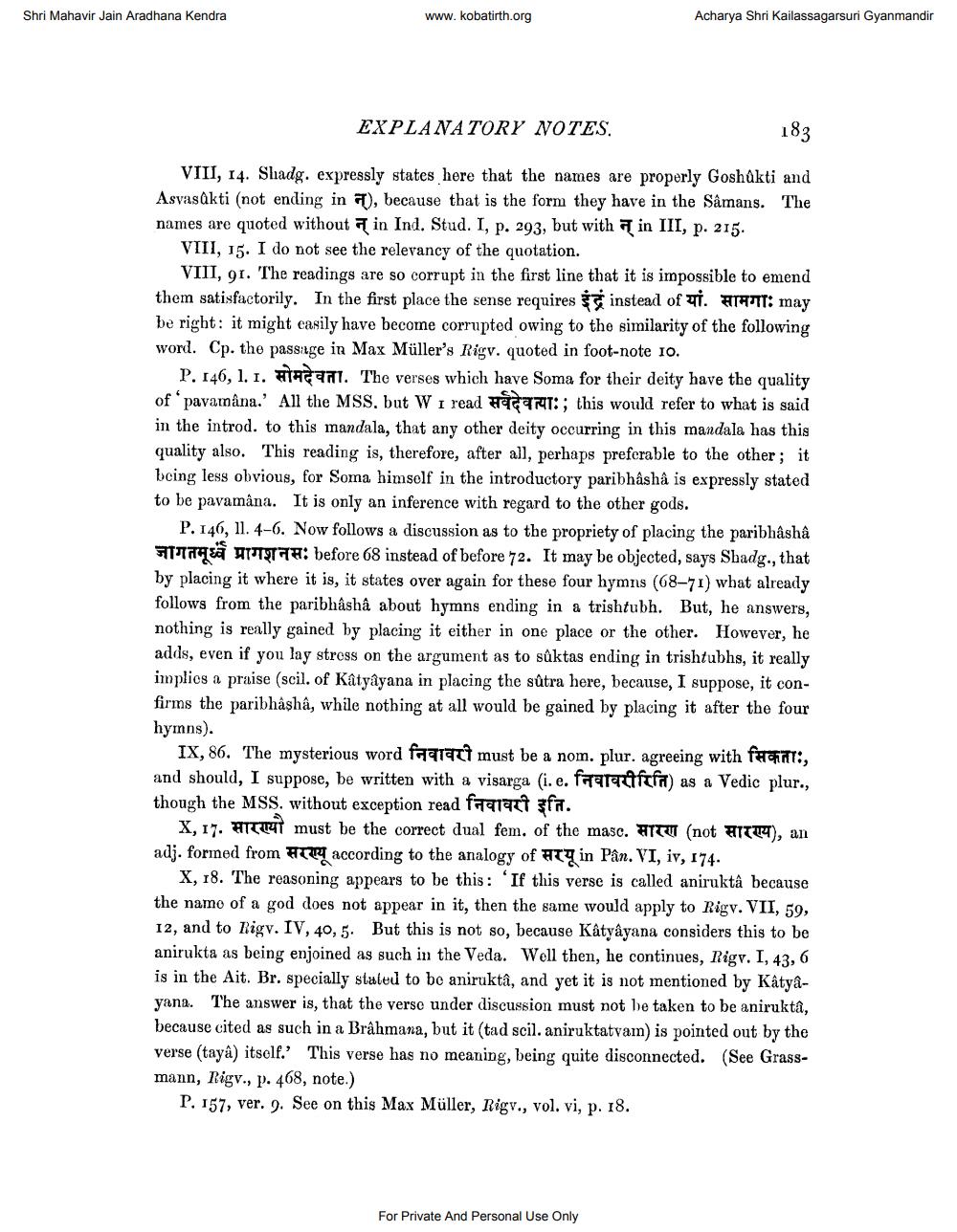________________
Shri Mahavir Jain Aradhana Kendra
www.kobatirth.org
Acharya Shri Kailassagarsuri Gyanmandir
EXPLANATORY NOTES.
183
VIII, 14. Shadg. expressly states here that the names are properly Goshakti and Asvasakti (not ending in 71), because that is the form they have in the Sâmans. The names are quoted without in Ind. Stud. I, p. 293, but with in III, p. 215.
VIII, 15. I do not see the relevancy of the quotation.
VIII, 91. The readings are so corrupt in the first line that it is impossible to emend them satisfactorily. In the first place the sense requires instead of Mİ. ATAT: may be right: it might easily have become corrupted owing to the similarity of the following word. Cp. the passinge in Max Müller's Rigv. quoted in foot-note 10.
P. 146, 1. 1. t al. The verses which have Soma for their deity have the quality of 'pavamâna. All the MSS, but W i read hearT:; this would refer to what is said in the introd. to this mandala, that any other deity occurring in this mandala has this quality also. This reading is, therefore, after all, perhaps preferable to the other; it being less obvious, for Soma himself in the introductory paribhasha is expressly stated to be pavamâna. It is only an inference with regard to the other gods.
P. 146, 11. 4-6. Now follows a discussion as to the propriety of placing the paribhâshâ Fr ATTTTH: before 68 instead of before 72. It may be objected, says Shadg., that by placing it where it is, it states over again for these four hymns (68-71) what already follows from the paribhashâ about hymns ending in a trishtubh. But, he answers, nothing is really gained by placing it either in one place or the other. However, he adds, even if you lay stress on the argument as to sûktas ending in trishtubhs, it really implies a praise (scil. of Kâtyâyana in placing the sûtra here, because, I suppose, it confirms the paribhashâ, while nothing at all would be gained by placing it after the four hymns).
IX, 86. The mysterious word faarat must be a nom. plur. agreeing with fhaint:, and should, I suppose, be written with a visarga (i.e. farazifeft) as a Vedic plur., though the MSS. without exception read faalatt fn. ___x, 17. सारण्यो must be the correct dual fem. of the mase. सारण (not सारण्य), an adj. formed from Hry according to the analogy of any in Pân. VI, iv, 174.
X, 18. The reasoning appears to be this: 'If this verse is called aniruktâ because the namo of a god does not appear in it, then the same would apply to Rigy. VII, 59, 12, and to Rigv. IV, 40,5. But this is not so, because Kâtyâyana considers this to be anirukta as being enjoined as such in the Veda. Well then, he continues, Rigv. I, 43, 6 is in the Ait. Br. specially staled to be aniruktâ, and yet it is not mentioned by Kâtyayana. The answer is, that the verse under discussion must not be taken to be anirukta, because cited as such in a Brâhmana, but it (tad scil. aniruktatvam) is pointed out by the verse (tayâ) itself.' This verse has no meaning, being quite disconnected. (See Grassmann, Rigv., p. 468, note.)
P. 157, ver. 9. See on this Max Müller, Rigv., vol. vi, p. 18.
For Private And Personal Use Only




